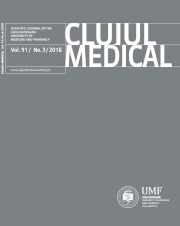Ferritin level changes and erythroid improvement in a group of adult politransfused patients treated with Deferasirox
DOI:
https://doi.org/10.15386/cjmed-942Keywords:
iron overload, iron chelating therapy, anemiaAbstract
Background and aims. Chelating agents therapy is recommended for polytransfused patients that have evidence of iron overload (an elevated serum ferritin or received over 20 units of red blood cell transfusions). Deferasirox showedefficacy and safety in maintaining or reducing body iron.Iron chelation therapy was associated with hematopoiesis improvement in transfusion-dependent patients.
Our objectives were to analyze differences in ferritin level in adult polytransfused patients treated with Deferasirox, to estimate the erythroid improvement and variation of the number of red blood cell transfusion after introducing Deferasirox, to evaluate the side effects of the treatment.
Methods. Retrospective study including all the adult polytransfused patients treated with Deferasirox in Hematology Departments of three county hospitals in the North-West of Romania.
Results. We included 40 polytransfused patients treated with Deferasirox in standard doses. There was a significant reduction in serum ferritine from baseline for all the patients (Friedman test, χ2(2)=26.82, p<0.001). Safety profile of Deferasirox was good (three digestive side effects). RBCT were administered before (mean 2.43±1.09 units/month) and after starting Deferasirox (mean 1.40±0.97 units/month), the difference is statistically significant (Student Test, t(39)=6.98, p<0.001).
Conclusions. Deferasirox proves to be an effective iron chelator, the serum level of ferritine decreased for all the patients during the treatment and 22.5 % of the patients developed an erythroid improvement. Safety and compliance were good.
Downloads
Additional Files
Published
How to Cite
Issue
Section
License
The authors are required to transfer the copyright of the published paper to the journal. This is done by agreeing to sign the Copyright Assignment Form. Whenever the case, authors are also required to send permissions to reproduce material (such as illustrations) from the copyright holder.

The papers published in the journal are licensed under a Creative Commons Attribution-NonCommercial-NoDerivatives 4.0 International License.

